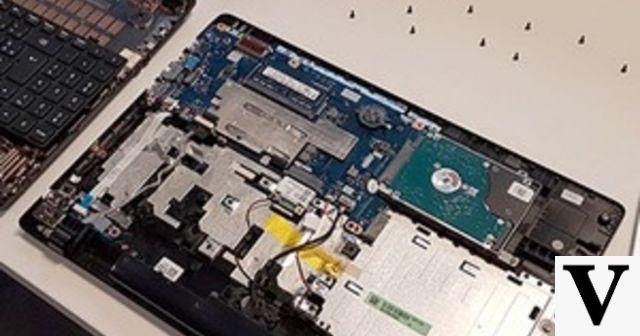
Entry-level laptops are often equipped with a platter hard drive. An aging storage solution that can't compete with the efficiency of an SSD. Good news: it's relatively easy to replace the first with the second. Here is how to do it.
We cannot repeat it enough: the SSD is good. The read and write speeds are beyond those of a hard drive and this is often the best way to give a new lease of life to an aging or entry-level laptop PC. This "tutorial" will guide you step by step, by approaching the cloning of the operating system, the opening of the PC, and the replacement of the hard disk. We also offer you, at the end of the article, a "before / after" performance comparison. We performed our operations on the Lenovo IdeaPad 100, an entry-level PC with an Intel Celeron processor, 4 GB of RAM and, by default, a 5400 GB 512 rpm hard drive. We're replacing it with a Crucial MX100 256GB SSD.
Prerequisites
- A 2,5-inch, 7 mm thick SSD to replace the hard drive
- A 2,5-inch external case, essential in the disk cloning stage
- Software to clone disks. We recommend, for example, EaseUS Todo Backup Home which is offered as a trial version for 15 days.
Step 1: clone your operating system
Nothing complicated to clone a disk, especially since EaseUS Todo Backup is very easy to use. First of all, you have to connect the SSD disk that will receive the copy of the system via USB via the external box. Then, once EaseUS Todo Backup has been launched, click on Clone top right.
To be sure that the entire system copies itself and that the SSD boots correctly once installed, check Hard drive 0. The software will then take all the partitions. Click on Next.
Now is the time to choose the SSD as the "target" disk, that is, the one that will receive the "raw" copy of the system. Here too, just check the box next to Hard drive 1 to choose it automatically.
Then validate the operation by clicking on Proceed. Copying will start after a few seconds. The operation can take up to 1 hours on an entry-level laptop PC such as Lenovo IdeaPad 30 with a 100 GB hard drive.
Step 2: Unmount the PC to install the SSD
Depending on your laptop PC, the operation is more or less long and more or less tedious. In the case of the IdeaPad 100, you need to access the motherboard and its components by removing both the underside of the chassis and the keyboard. Start by removing the 13 screws from the bottom.
Then use a very thin plastic card to "pop" the keyboard. Warning: do not pull it too hard, because you have to remember to remove the cable that connects it to the motherboard, by gently lifting the hanging system. 7 additional screws must then be removed.
Before gaining access to the motherboard for good, a final step asks you to remove the two screws from the chassis on the side of the optical drive that you have removed beforehand.
If all went well, you can then easily remove both the keyboard and the lower part of the PC chassis. You will then have access to the entire motherboard, and thus to the original hard drive. The hardest thing is done.
All you have to do is remove 4 screws and disconnect the hard drive. Important detail: in the photo below, a small "Lenovo" sticker hides one of the screws. One way for the manufacturer to verify that the PC has not been opened. In which case, you can say goodbye to your warranty.
Once the SSD is installed and the PC reassembled and turned on, you should feel the difference from the start. Thus, with its original hard drive, our IdeaPad 100 test took about 2 min 20 s to fully boot. With its new SSD, it now boots in 55 s. Same story for launching an application: with the basic storage system, the Chrome browser takes 17 seconds for a first launch. A figure that goes down to 8 s when switching to SSD. Finally, the CrystalDiskMark tool, which analyzes the performance of a storage device, can see real differences, as you can see in the image below. The speed is more than doubled.
On the right, the performance of the original hard drive. On the left, those of the SSD.
So of course, the Intel Celeron processor here onboard remains very weak anyway, but switching from an HDD to an SSD allows, on average, to double the performance of the machine.


























